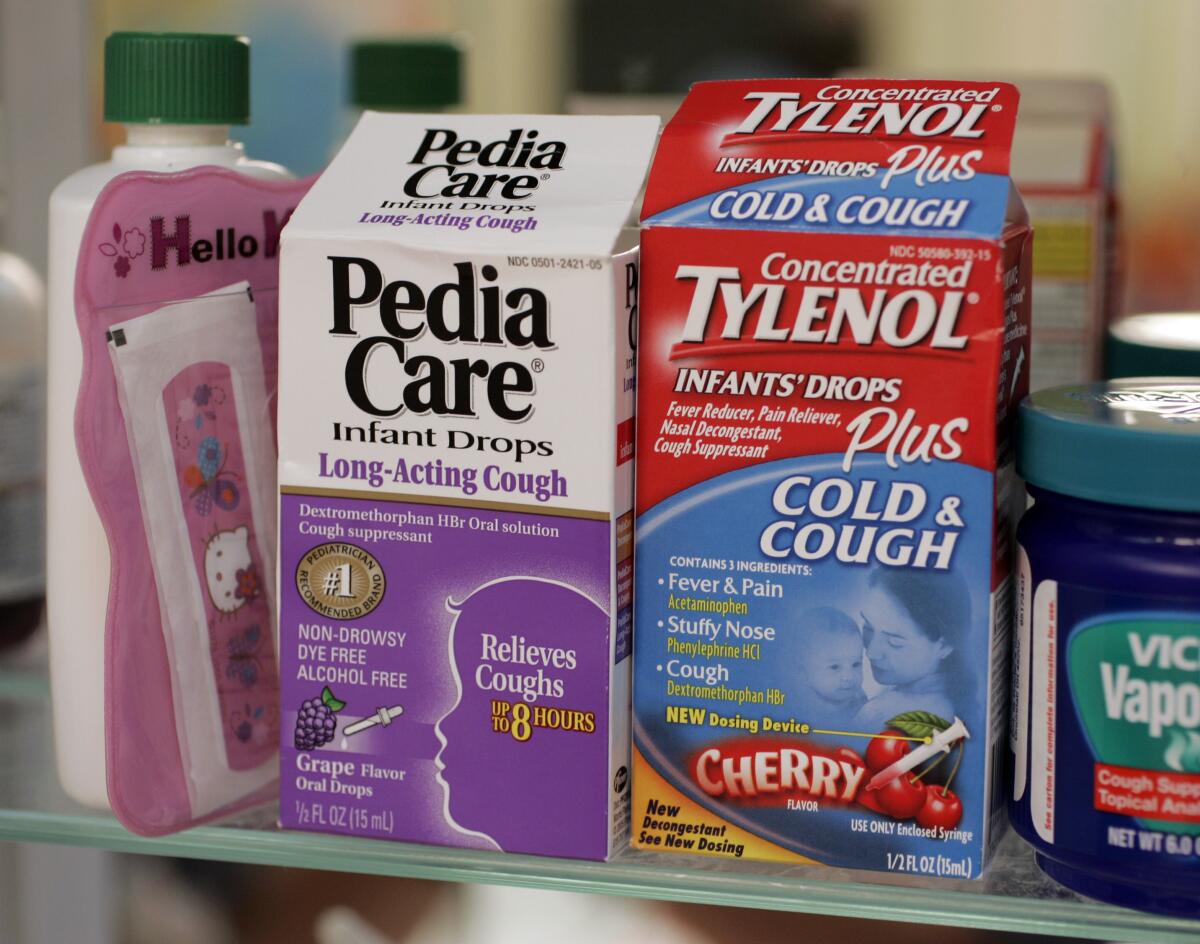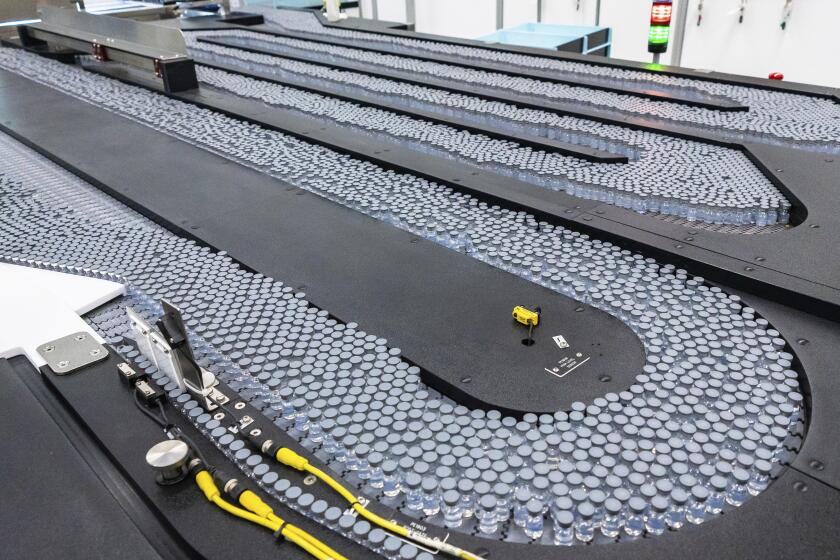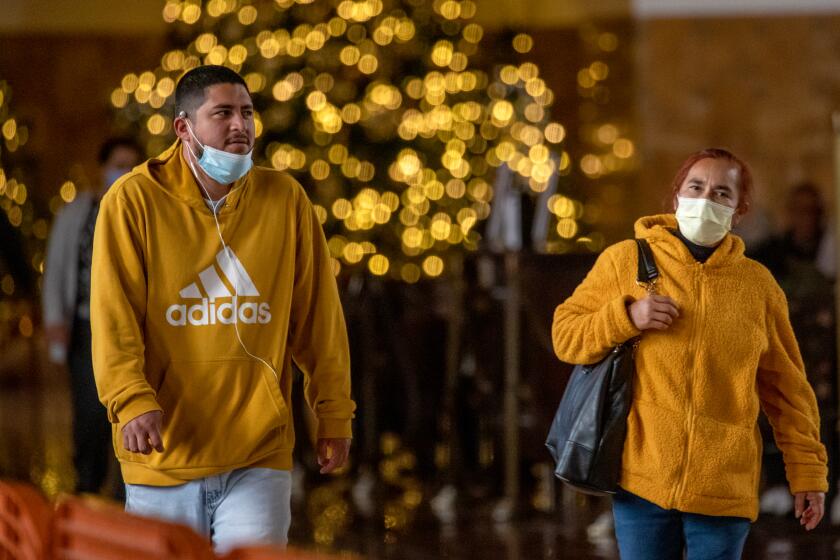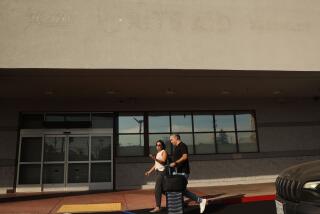As flu surges, L.A. faces shortages of kids’ medications. Stockpiling can make it worse

- Share via
As flu season approached, Antonieta Garcia knew it was time to replenish her supply of cough suppressants and fever reducers. But this year, she often walks into a store and finds only empty shelves.
The 44-year-old East Los Angeles mother of two tries to keep a fully stocked medicine cabinet because her 2-year-old is immunocompromised and her 12-year-old has asthma. One cold or flu could mean a trip to an ER, and with a surge in respiratory illnesses driving up demand for kids’ medicine, Garcia said she feels like she’s fighting a war on all fronts.
“As soon as the RSV [respiratory syncytial virus] and the flu season started, that’s when I saw there was hardly any cough medication, there’s hardly any Tylenol or ibuprofen,” she said. “I don’t want to exaggerate, but I decided I had to stock up.”
With COVID-19, flu and RSV cases rising in children, drugmakers and retailers say it’s soaring demand — not a shortage in supply — that’s leading to empty shelves. And stockpiling by parents who fear they won’t be able to find medicine when they need it could make the problem worse.
Across the country, pharmacies working to restock quickly are struggling to keep up, echoing the early-pandemic shortages of toilet paper, hand sanitizer and some medicines.
Some parents who dealt with those shortages worry about how long shelves will stay empty. Garcia said she now starts every trip to Target or the supermarket at the medicine aisle.
“It’s hard,” she said. “If you can’t find [medicine], then I have to end up in the hospital.”
California is simultaneously contending with a spike in coronavirus transmission, an early onslaught of RSV and a strong start to the flu season.
Johnson & Johnson, the maker of Tylenol, said that it is running production facilities 24 hours a day and that there is no shortage of its products in the United States.
“We continue to experience high consumer demand,” the company said in a statement. “We are doing everything we can to make sure people have access to the products they need, including maximizing our production capacity, and running our sites 24 hours a day, seven days a week.”
Parents’ difficulty in finding over-the-counter cold medication has been due to a surge on the demand side, not any problems on the supply side, the Consumer Healthcare Products Assn. said.
“Manufacturers are producing at full capacity and directing product inventory to where it is needed most,” the association said in a statement. “However, we understand it might be frustrating for parents to quickly locate these products from their usual pharmacy or retailer due to intermittent out-of-stocks. Parents may have to make a few stops to find what they need, and should also consider additional self-care alternatives.
“We want to further reiterate the importance of responsible purchasing practices,” the statement continued. “Media coverage surrounding this issue could prompt parents to ‘stock up’ if a product shortage is perceived or feared — which could eventually cause widespread supply shortages for U.S. consumers.”
With the steep increase in demand in the last couple of weeks, retailers said, doctors and pharmacists are ready to offer alternatives to treat infections or reduce pain and fevers in children.
“Similar to others in the industry, we are seeing constraints on Children’s Tylenol due to ingredient supply chain issues and increased demand,” a spokesperson for Rite Aid said in a statement. “If a customer arrives in a store to find we don’t have a product they’re seeking, our pharmacists are here to provide recommendations for equivalent products and alternative treatment options.”
The updated bivalent COVID-19 booster shots are available at more than 1,500 sites in Los Angeles County. Here’s how to get one.
A spokesperson for CVS said the chain is working with suppliers and has a replenishing process in place if “a local store experiences a temporary product shortage.”
Walgreens has been “able to meet customer needs” despite the increased demand, a spokesperson said, and teams have worked year-round to prepare and forecast demand.
Rebecca Schenker first noticed the empty shelves in late November.
Both of her kids became sick during Thanksgiving week, running fevers as high as 103 degrees, she said.
She had medicine ready, but when she tried to replenish the Children’s Tylenol that her kids emptied out during their illness, she saw she couldn’t order any online.
“You can’t buy it, or pick it up, or order to the store, or anything,” she said. “No name brand, no generic brand, nothing.”
With the flu, RSV and COVID-19 on the rise, Schenker said, she wanted to make sure she was ready if anyone in her house got sick. She settled on chewable ibuprofen tablets for her kids.
With Orange County declaring a health emergency due to high RSV cases, concern about the virus is peaking. Here’s what you should know about it.
“If my kids get sick in the next few weeks, I want to make sure it’s on hand,” she said. “Everybody I know is dealing with these mega-colds or flus, or whatever it is.”
Flu cases in California have increased to levels that haven’t been seen in years. According to the Centers for Disease Control and Prevention, seasonal influenza activity is high and continuing to increase across the country. As of this week, 14 pediatric flu deaths have been reported nationwide this season, including one in Los Angeles County.
Since early October, the Los Angeles County Department of Public Health has seen a significant increase in the percentage of specimens that have tested positive for influenza.
The county’s positivity rate for flu for the week ending Nov. 19 was over 25%, and influenza-like illnesses accounted for more than 12% of all emergency room visits. Both figures were an increase from the week before.
Pneumonia, influenza and COVID-19 also accounted for 11% of all deaths in the county that week — also an increase from the previous week.
Health officials have also noted that coronavirus case counts have been climbing steadily in L.A. County, sending more people to hospitals and raising the possibility that indoor mask mandates could go into effect by January. For the week ending Thursday, the county reported an average of 3,780 new cases a day, or about 262 new cases per 100,000 residents.
A rate of 100 or more cases per 100,000 residents is considered high.
Should hospitalization rates continue to rise this month, the county could be on track for a renewed universal mask order in indoor public settings. But that’s not assured.
Amid the surge in illness, the difficulty in finding drugs such as Tylenol hasn’t hit just stores in the U.S. In Canada, government officials issued emergency orders allowing for drugs with acetaminophen and ibuprofen to be imported from the U.S. and Australia, the Wall Street Journal reported.
In addition, the American Academy of Pediatrics has said that a shortage of liquid amoxicillin — an antibiotic used to treat pneumonia, bronchitis and infections in the ears, nose and throat — is likely to last months.
In response to the shortage of antibiotic and over-the-counter medications, officials have noted there are possible substitutions available for parents.
Schenker, who also cares for an elderly relative, said she’s ready with medicine for her kids but worried about what the empty shelves mean.
“When you can’t find cold medicine for your kids, it means all the kids are sick,” she said. “I’m telling my friends, make sure you’re stocked for now. But maybe buy one or two so other parents can also buy some.”
More to Read
Sign up for Essential California
The most important California stories and recommendations in your inbox every morning.
You may occasionally receive promotional content from the Los Angeles Times.















